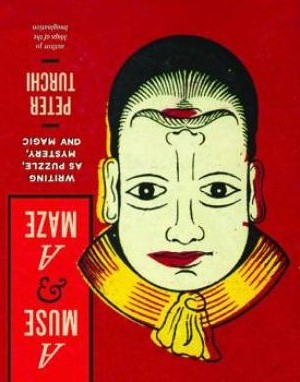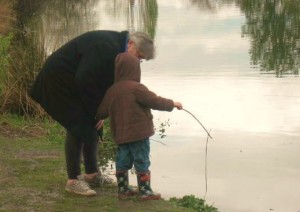“…every well constructed piece of fiction has elements of a puzzle, and every piece of fiction that means to provoke readers to a state of wonder or contemplation has at least some element of mystery. “
— Peter Turchi, A Muse and a Maze: Writing as Puzzle, Mystery and Magic —
A Muse and a Maze: Writing as Puzzle, Mystery and Magic
Peter Turchi
Trinity University Press, 2014
244 pages, $29.95
ISBN 9781595341938
/
Ten days before Christmas 2014, Powell’s Books in Portland posted its online list of Best Books of 2014, prefacing the post with these words: “Here are the new releases across six categories that left us inspired, bewildered, and a little bit wiser.” Books that leave us inspired and a little bit wiser – these are the conventional guidelines for choosing favorites. Who doesn’t want that from a good book? But then there’s that other word: “bewildered.” That word makes us pause. Really? Do we want to be bewildered by the stories and poems we read?
Peter Turchi answers that question with a resounding yes in his intriguing (and, yes, bewildering and inspiring) new book, A Muse and a Maze: Writing as Puzzle, Mystery and Magic. To leave readers slightly bewildered, to leave them with some questions answered but also with the understanding that other questions are unanswerable, to challenge readers to be satisfied with uncertainty – that’s exactly what Turchi encourages in this book.
Though equally interesting for the general reader, A Muse and a Maze (the title itself is a bit of a game) is directed mainly at writers. The writer Robert Boswell in an interview for Fiction Writers’ Review says, “It’s not a craft book but a rumination on the impulse to write and how that impulse may be related to other human desires.”
So A Muse and a Maze is not a textbook, nor is it a manual. It is not divided into the usual craft-book chapters addressing point of view, voice, syntax, setting, characterization, plot (Turchi’s analysis of work by Chekhov suggests we think hard about whether stories are really just about events), and structure, though the book addresses all of those and then some over the course of its six offbeat sections (plus introductory notes entitled “The Contemplation of Recurring Patterns”):
1. Directions for Attaining Knowledge of All Dark Things
2. How, from Such Wreckage, We Evolve the Eventual Effect
3. Seven Clever Pieces
4. The Treasure Hunter’s Dilemma
5. The Line, the Pyramid, and the Labyrinth
6. The Pleasures of Difficulty
What Turchi has done in this book is examine a fiction writer’s attitude toward his material, with writers compared initially to puzzle-makers (in the style of Will Shortz, crossword puzzle designer for the New York Times, and Howard Garns, the inventor of what we now know as Sudoku) and magicians (a la Harry Houdini.) Seen from this perspective, the writer’s job is to make conscious choices about the puzzle or the illusion he or she is creating, in order to produce a certain “effect.” To be able to do that, Turchi explains, is to control not necessarily what the audience sees, but what the audience thinks it sees (and, he adds later, what the audience wants to think it sees.) Writing, like magic, is about “the creation of a credible illusion” – with the key aspect being credibility (with credibility often established by a careful writer’s observation and recognition of recurring patterns.)
Interestingly, the word “illusion” is used more often by magicians than the word “trick,” which suggest gimmickry at the heart of their work. Turchi explains that Harry Houdini, who used gimmickry (mirrors in a box) for his famous Disappearing Elephant illusion, cut the elephant out of his act when he realized the audience reaction to its disappearance was lukewarm. His admirers were much more captivated by his fabricated identity — Houdini, the exotic, bare-chested escape artist who defied death.
With most puzzles the goal is limited to finding a solution. Not so with fiction:
The composer of a puzzle means to present a challenge, but also intends for his audience to solve it. A magician presents an illusion with the understanding that, while it can be “solved,” or explained, his purpose is to disguise that solution so we can experience something that, however briefly, transcends rational understanding. It’s tempting to say that a writer, then, is a kind of magician.
Turchi encourages us to resist that temptation. He does a fine job of delineating what genre writers offers us – they are the performers, the magicians, offering us entertainment and a solution to the puzzle; in his description of this type of writing, he doesn’t adopt an attitude of superiority; as a puzzle-lover himself, Turchi appreciates a good detective novel, but he persuades us that the destination of the typical mystery is that solution to the whodunit. There is a crime, clues are dispensed prescriptively along the way. The click of the puzzle-box closing – that’s what is required by readers of genre fiction. In other words, Professor Plum killed Ms. Scarlet in the Conservatory with the candlestick. End of game.
Literary fiction (or mysteries that move a more literary direction) is similar to puzzle-building (the “strategic arrangement” of pieces of the narrative) with this important difference:
…while composing a piece of fiction is like assembling a puzzle, the finished work is not presented by the writer as a puzzle for the reader to solve. There may be puzzles within the story, elements of plot or character or imagery or meaning that require the reader’s active participation, but the story as a whole is not a problem with a solution. Like Ariadne’s thread allowing Theseus to journey into –and out of – the mythical labyrinth, a story means to lead the reader somewhere. But the destination isn’t a monster, or a pot of gold, or a bit of wisdom. Instead, the destination is something – or several things – to contemplate. The best stories and novels lead the reader not to an explanation, but to a place of wonder.
Puzzles, then, can be elegant combinations of functionality, clarity, economy and cleverness, but they are closed systems; stories (at least the kind that linger) are open.
In a recent interview Turchi said, “… one of my goals was to explore the seemingly perverse pleasure to be had from constraints, or form. The joke of Calvinball in the Calvin and Hobbes comic was that a game with no rules is exhausting.” Both puzzles and poetry can be subjected to formal constraints – the formal requirements of a villanelle, for example, can be compared to the rules of Sudoku, and Turchi obliges us with a list of said constraints for both; he is among the endangered species of people who believe constraints help, rather than hobble, beginning writers, giving them “a container to work in and against.” Leonardo da Vinci, too, was a fan of rules: “Art lives from constraints and dies from freedom.” Of course, the trick (or is it an illusion?) is to make the constraints invisible to the audience.
The book offers up discussions, too, of the fluidity of language, the multiplicity of selves, the concept of “flow state,” the idea of artistic obsession (softening the sound of that sometimes by calling it “devoted attention”) and the cultivation by writers of curiosity and observational skills; there is a stimulating section about “difficulty” in fiction, and the idea of narrative non-linearity. Turchi suggests a new openness in today’s world to experiments with structure and sees that experimentation running parallel to an increased interest in game-playing technologies. He encourages openness to the way narrative structures can be turned upside down and inside out, backwards, forwards, in fragments, in meta-textual ways, defying convention, and he has plenty of examples to support that approach – not bad for a man who also appreciates what formal constraints can teach us. Turchi is always careful to moderate his enthusiasms with a few warnings; for example, he enjoys “mystery” in the sense of a reader being left contemplating unanswerable questions and/or the darker side of our characters, but he warns us that stories should not “collapse under the weight of uncertainty.” Few stories succeed without some kind of plot line; as Turchi says “…without that horse and the snowy evening we’d care less about why Robert Frost was in a funk.”
The author takes a focused look at several writers – Herman Melville, Samuel Clemens (like Houdini, a fabricated identity), F. Scott Fitzgerald, Anton Chekhov – and glimpses at a dizzying number of other artists, including visual artists (Anish Kappor, Charles Ritchie, Norman Rockwell, Van Gogh) and verbal artists (Jerry Seinfeld); Lewis Carroll (master mathematician, puzzle-maker and writer) gets a look, as do Michael Ondaatje, James Salter, Raymond Chandler, David Shields, Graham Greene, Vladimir Nabokov, and John Updike, among others (such as the Wizard of Oz.) One of my favorite quotations among many highlighted in the book is delivered by Tim O’Brien:
Characterization is achieved…through a process that opens up and releases mysteries of the human spirit. The object is not to “solve” a character – to expose some hidden secret – but instead to deepen and enlarge the riddle itself.
I thought often, as I read this book, of Warren Motte, whose book Mirror Gazing I reviewed in Numéro Cinq’s June 2014 issue. Turchi’s discussion of the multiplicity of selves within each character we create made me think about the act of looking into mirrors, and how we then ask ourselves, “Who am I? How have I become who I am?” As readers or movie-watchers, what we want to see and think about are the “stress fractures in the surface of a character.” Using tangrams (there is one to cut out on the last page of the book) Turchi talks about how shapes/characters are assembled via the rearrangement of “seven clever pieces.” With Walt Whitman’s famous line (“I contain multitudes”) resounding in our ears, the answer to “Who am I?” seems to depend on who is doing the arranging. There is “no single logical sequence….only possibilities to ponder, ”says Turchi.
The author suggests his new book as a companion, not a sequel, to his equally interesting book about the process of writing, Maps of the Imagination. “Both books are, at least in part, about ways in which a piece of writing is designed. They both mean to invite writers to think differently about what we do.” He’s eager to have us remember that there is playfulness, in addition to effort, in art, and he bemoans the fact that a sense of delight in the creation of art often gets overlooked in conversations about craft. The author’s own sense of humor comes shining through – this is not dusty, academic writing. Nor does it limit itself strictly to writing advice. The author allows himself to comment on the culture at large:
The patience and willingness to embrace complexity seems particularly important these days, when much of the rhetoric of business and politics is devoted to reducing and simplifying people and problems. Easy understanding comes at a high price. One of the things fiction and poetry can do is to remind us of the value of refusing to rush to judgment, the need not just to recognize, but to accept, complexity and mystery.
In the interview at Fiction Writers Review, Turchi says, “…in talking about the virtues of obsession I’m really talking about the virtues of sustained concentration, of patience.”
Reader beware: Numerous brain-teasing puzzles are inserted into both text and margins of this book, making it difficult to turn the page before trying to find solutions. Either grab your pencil and write directly into the book as you look for the answers, or – if you’re less obsessive about puzzle-solving – move on and stick to the task at hand: reading Turchi’s text. The puzzles really do exert a pull, though, even if they reminded me occasionally of the logic puzzles I failed to solve in my Graduate Record Exams – the ones that begin “John, Daniel, Mary, Jeanette and Olivia all have flags of different colors…” You know the type. They make my head hurt. Pages 28 and 29 involve an acrostic designed especially for the book by puzzle-man Michael Ashley – if you can solve it, you can enter your answer online and try to win a jigsaw puzzle of the cover of the book.
The cover, by the way, extends the discussion of the multiplicity of selves by portraying two young men in the same face – turn the cover upside down and you see someone with black hair, wide red lips and a golden collar; right-side-up the collar becomes a turban, and the man has a mustache and black beard. It’s amusing. And amazing. And bewildering. And fun.
— Julie Larios
Julie Larios is a Contributing Editor at Numéro Cinq. She is the recipient of an Academy of American Poets prize and a Pushcart Prize, and her work has been chosen twice for The Best American Poetry series.




So much good stuff in this piece. I’ve been thinking a lot lately about the value of constraints. As a case in point, I recently read that Dr. Seuss wrote “Green Eggs and Ham” after his editor bet him he couldn’t write a book using only fifty words. Guess who won the bet.